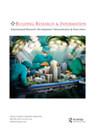Barriers and enablers for scaled-up adoption of compressed earth blocks in Egypt
IF 3.7
3区 工程技术
Q1 CONSTRUCTION & BUILDING TECHNOLOGY
引用次数: 1
Abstract
ABSTRACT Compressed earth blocks (CEBs) are a low-cost, low-carbon construction product, which are well-suited for masonry infill in the Global South. A knowledge gap remains around the technical and socio-economic barriers to CEB adoption. A combined survey and interview study was carried out among architects, CEB manufacturers, and academics within Egypt: firstly, to explore technical and socio-economic barriers to greater adoption of CEBs for masonry infill, and secondly, to identify potential enablers. Many technical challenges still exist, despite the fact that building codes for CEB in Egypt were introduced in 2019. The majority of respondents agreed that socio-economic barriers are more significant than technical barriers. These included CEBs being unfamiliar to most architects and builders, and that most clients perceive CEBs as ‘low-quality’ or ‘inaesthetic’. Most respondents believed that CEBs can achieve ≥25% market share for masonry in Egypt. However, CEB press supply is likely to be a major barrier to scale-up. Suggested enablers included tailored marketing suggestions for low-/middle-income and high-income clients, and deciding at the earliest possible design stage whether to manufacture CEBs on-site or off-site. Mapping the enablers across stakeholders showed that more research is needed to understand the views of CEB press manufacturers and government officials.埃及大规模采用压缩土块的障碍和促成因素
摘要压缩土块(CEBs)是一种低成本、低碳的建筑产品,非常适合全球南方的砌体填充。关于采用行政首长协调会的技术和社会经济障碍,仍然存在知识差距。在埃及建筑师、CEB制造商和学者中进行了一项综合调查和访谈研究:首先,探索更多采用CEB进行砌体填充的技术和社会经济障碍,其次,确定潜在的推动者。尽管埃及行政首长协调会的建筑规范于2019年出台,但仍存在许多技术挑战。大多数答复者一致认为,社会经济障碍比技术障碍更为重要。其中包括大多数建筑师和建筑商不熟悉的CEB,以及大多数客户认为CEB“低质量”或“不美观”。大多数受访者认为,CEB可以在埃及获得≥25%的砌体市场份额。然而,行政首长协调会的新闻稿可能是扩大规模的主要障碍。建议的促成因素包括为中低收入和高收入客户量身定制的营销建议,以及在尽可能早的设计阶段决定是在现场还是在场外制造CEB。绘制各利益攸关方的促成因素图表明,需要更多的研究来了解行政首长协调会印刷机制造商和政府官员的观点。
本文章由计算机程序翻译,如有差异,请以英文原文为准。
求助全文
约1分钟内获得全文
求助全文
来源期刊

Building Research and Information
工程技术-结构与建筑技术
CiteScore
8.60
自引率
7.70%
发文量
43
审稿时长
>12 weeks
期刊介绍:
BUILDING RESEARCH & INFORMATION (BRI) is a leading international refereed journal focussed on buildings and their supporting systems. Unique to BRI is a focus on a holistic, transdisciplinary approach to buildings and the complexity of issues involving the built environment with other systems over the course of their life: planning, briefing, design, construction, occupation and use, property exchange and evaluation, maintenance, alteration and end of life. Published articles provide conceptual and evidence-based approaches which reflect the complexity and linkages between cultural, environmental, economic, social, organisational, quality of life, health, well-being, design and engineering of the built environment.
 求助内容:
求助内容: 应助结果提醒方式:
应助结果提醒方式:


